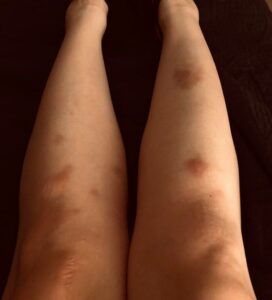Trigger Warning: Child Abuse, Sexual Abuse, Medical Trauma
Hello, everyone! I know it has been a very long time since I wrote to you here. One of these days, I will be able to tell you the entire story of why I haven’t been able to be as open to the world as I used to be. For now, I will tell you the vulnerability I have always cherished in writing was used to try to fight a battle I didn’t think could possibly hurt me more than EDS does. I didn’t expect what happened after, the publicity, the sudden move away from my home, and ultimately, some really severe PTSD I’m still not quite sure how to handle. For most of my life, I wanted people to know my name and to fight for what I believed in–until my name and fighting for what I believe in almost destroyed my life. I’m doing a lot better now than I had been. I have had a lot of help and support from a lot of people, many of them in this community–and I so appreciate the patience people have had with me as I have tried to navigate venturing back out into the public. My passion has never wavered, but my abilities and my needs have.
May is EDS Awareness Month, as most of you know. I posted a photo in my Snapchat story last night with the caption “Thanks, EDS” and giggled a little with my husband about it. Tammy (our wonderful leader) saw it this morning and mentioned I should share it with you for awareness this month. She was right. The picture is funny if you KNOW you have EDS. Your legs probably look like mine or at least they have looked like mine and they will again. It’s not so funny if you don’t know you have EDS and has the opportunity to educate a lot of people. So, here’s the photo:

Just a Regular EDS Night
I remember growing up and getting hurt many times. It seemed like I was spraining joints more often than I was taking spelling tests. The nearest ER was a frequent stop, so much so I think we had a running joke about a punch card for a free visit after ten stops. Back then, though, I was just a kid, covered in bruises, hurt again. I wasn’t diagnosed with EDS until March of 2016, when I was 25 years old. I always knew what was coming when we went for these visits. I would wait for the worst part. They would ask my mom to leave the room and then ask me questions to make sure I wasn’t being abused at home. Make no mistake about this: recognizing the signs of child abuse is an absolutely critical part of medical care. It was challenging for me because I am the victim of child molestation and I waited 11 years to come forward about it. When they wanted my mom to leave the room to ask me about whether or not she was safe, I was afraid they might figure out the other “thing” or take me away from the person who did keep me safe, the one who kept taking me to doctors no matter how far away the drive, no matter how many of them told her I was fine. I knew she was getting asked questions in the hallway. I knew they were looking for differences in our stories, keeping track of how many times I’d fallen off my bike. I remember even at 13 years old being confused about why she would bring me in covered in these bruises and asking for help if she were trying to hide something.
I wish my mom had known then what we know now and could have advocated for me. When my husband and I go to the ER now, which we still avoid but now only for a lack of knowledge about the more rare of my conditions, Hypophosphatasia, we are able to have them access my electronic medical records to see that I am a patient with Ehlers-Danlos Syndrome. My pain specialist makes himself available for calls about the condition in case they do have questions about the easy bruising. You see, I don’t know where one single one of these bruises came from. My husband is a VERY patient man who would never in a million years lay his hands on me, but I also could literally bump into him when walking across the living room and end up with one of them. I have bruised myself with one of the worst bruises I have ever seen from my own wheelchair, a device meant to limit injury to my person.
Why am I writing this now? I want people who might have legs that look like this to know what to ask their doctors. I want them to know the questions to ask that my mom didn’t know to ask and NOT for lack of trying. We had no idea what EDS was. More than that, though, I want doctors to know what else might cause someone to look like this. I want them to know it is so important to know the signs of abuse, but also to know how to test for conditions that might make me look like this from absolutely nothing abuse-related. I want them to understand this could be caused by the patient’s DNA and a bump into a kitchen counter. None of these bruises hurt when they happened or I would know where they came from.
Maybe the patient who is constantly in the ER with seemingly silly explanations for their injuries, like falling up the stairs (I can’t remember how many times I did that) and also with bruises on them like this also has stretchy skin, hypermobile joints, migraine headaches, and chronic pain. Maybe, that ER doctor could answer their questions or refer them to someone who can before they’re 25 years old and convinced they’re crazy. Maybe that child won’t be afraid about when their mom gets called into the hallway because their mom will already know to tell the physician that since the last visit, they saw another doctor and now they know the child has Ehlers-Danlos Syndrome, which is what is causing the easy bruising and susceptibility to injury–and the medical records will support that and eliminate the trauma of that fear.
The bruises aren’t fun, but the bruises on our mental health from not knowing for so long are much worse. You can’t see collagen, but there are visible signs of the defective version.
Thank you again for your patience, support, and love. I am blessed to be in a community of people who support each other no matter what. I look forward to writing to you more again.
-Stephanie
PS: To brighten the mood after such a tough topic, here are cute photos of my dogs:

Essex “Boo Boo” Vander Paws

Aura Charlotte Vander Paws




